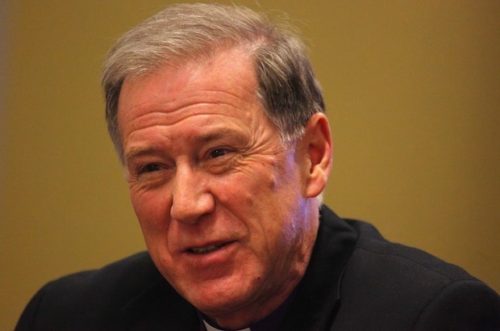Canada: ‘Spirit-filled, spirit-led’ gatheringPosted Jul 15, 2013 |
|

The Joint Assembly had a “very positive, upbeat spirit,” says Archbishop Fred Hiltz, primate of the Anglican Church of Canada. Photo: Art Babych
[Anglican Journal] Archbishop Fred Hiltz described the recently concluded Joint Assembly as a “spirit-filled, spirit-led” gathering that can only strengthen the full communion relationship of the Anglican Church of Canada and the Evangelical Lutheran Church in Canada (ELCIC).
“The very fact that these two churches, who have all kinds of challenges in front of them, were prepared to make this step to meet is really quite incredible,” said Hiltz, primate of the Anglican church. “What I saw through the Joint Assembly was a very positive, upbeat spirit.” The assembly was held July 3 to 7, at the Ottawa Convention Centre.
Hiltz said the idea of sharing resources and working more closely together resonated with delegates. “Maybe we could have a national office someday…I think that’s how people were feeling,” said Hiltz in an interview.
He said that when the moment came for the plenary hall to be divided into two so that Anglicans and Lutherans could attend to their own church’s business agenda separately, he heard both Anglicans and Lutherans say that all of a sudden they felt rather small. Others expressed the view that when the wall came, “all of a sudden we started focusing in on ourselves.”
Together for the Love of the World, the theme of the assembly, found expression in the joint declaration on homelessness and resource extraction and in the youth event on Parliament Hill that called for access to clean water in indigenous communities, said Hiltz.
“People had a sense that we really were together for something bigger than ourselves,” he added.
Hiltz expressed the hope that delegates who watched him and ELCIC national bishop Susan Johnson chair a joint assembly saw “some modeling of shared leadership that was encouraging for them in the local context.” Hopefully, he said, “we might see some joint local synods and conventions.”
As for General Synod, Hiltz said although it was a much shorter meeting, “we did in fact get our work done.”
The primate said he was not surprised that the resolution asking the Council of General Synod to prepare a resolution for 2016 that would change the marriage canon to allow same-sex marriage “sparked some difficult moments.”
Asked to comment on opinions expressed by some members that there wasn’t enough time to debate on the merits of the resolution, Hiltz said, “It doesn’t matter what kind of resolution you have on the floor that’s going to change the marriage canon of the church so that same-sex couples can be married. It’s going to be controversial.”
Reacting to statements made by some members that allowing same-sex marriage is a big leap from the blessing of same-sex unions, the primate said, “None of that surprises me. There’s nothing new in that perspective; that’s been there in the life of the church for many years.”
Hiltz acknowledged that the debate should have been focused on whether or not General Synod wanted to direct CoGS to prepare the marriage canon resolution for 2016. “The debate, in large measure, ended up being about people’s expression of disagreement around the blessing of same-sex union or marriage,” he said.
With regard to the procedural error that he made on the vote to the marriage canon resolution, Hiltz said he was “very grateful and proud” that the synod was patient with him and allowed him to correct the situation. “I found that to be a very moving moment when the synod would listen to the chair, step back, listen to the mistake he’s made so that, whatever the outcome is, due process would have been followed.”
As for what he considered to be highlights of the meeting, Hiltz noted General Synod’s approval of an indigenous diocese in northern Ontario, and its passage of the resolution setting out the criteria for choosing future national indigenous Anglican bishops and members of the Anglican Council of Indigenous Peoples and Sacred Circle, as examples.
“They were all wonderful moments. You can see that a new day is dawning for indigenous people and their sense of place within this church,” he said. “It was wonderful to see the joy of the synod…the absolute respect as the elders came in and took their places.”

Social Menu